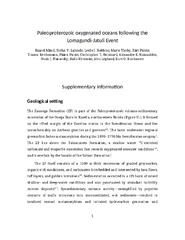Blar i forfatter "Lalonde, Stefan V."
-
Iron Isotopes Reveal a Benthic Iron Shuttle in the Palaeoproterozoic Zaonega Formation: Basinal Restriction, Euxinia, and the Effect on Global Palaeoredox Proxies
Mänd, Kaarel; Lalonde, Stefan V.; Paiste, Kärt; Thoby, Marie; Lumiste, Kaarel; Robbins, Leslie J.; Kreitsmann, Timmu; Romashkin, Alexander E.; Kirsimäe, Kalle; Lepland, Aivo; Konhauser, Kurt O. (Journal article; Tidsskriftartikkel; Peer reviewed, 2021-03-31)The Zaonega Formation in northwest Russia (~2.0 billion years old) is amongst the most complete successions that record the middle of the Palaeoproterozoic era. As such, geochemical data from the formation have played a central role in framing the debate over redox dynamics in the aftermath of the Great Oxidation Event (GOE). However, uncertainty over local redox conditions and the degree of ... -
Palaeoproterozoic oxygenated oceans following the Lomagundi–Jatuli Event
Mänd, Kaarel; Lalonde, Stefan V.; Robbins, Leslie J.; Thoby, Marie; Paiste, Kärt; Kreitsmann, Timmu; Paiste, Päärn; Reinhard, Christopher T.; Romashkin, Alexandr E.; Planavsky, Noah J.; Kirsimäe, Kalle; Lepland, Aivo; Konhauser, Kurt O. (Journal article; Tidsskriftartikkel; Peer reviewed, 2020-03-16)The approximately 2,220–2,060 million years old Lomagundi–Jatuli Event was the longest positive carbon isotope excursion in Earth history and is traditionally interpreted to reflect an increased organic carbon burial and a transient rise in atmospheric O<sub>2</sub>. However, it is widely held that O<sub>2</sub> levels collapsed for more than a billion years after this. Here we show that black shales ...


 English
English norsk
norsk
